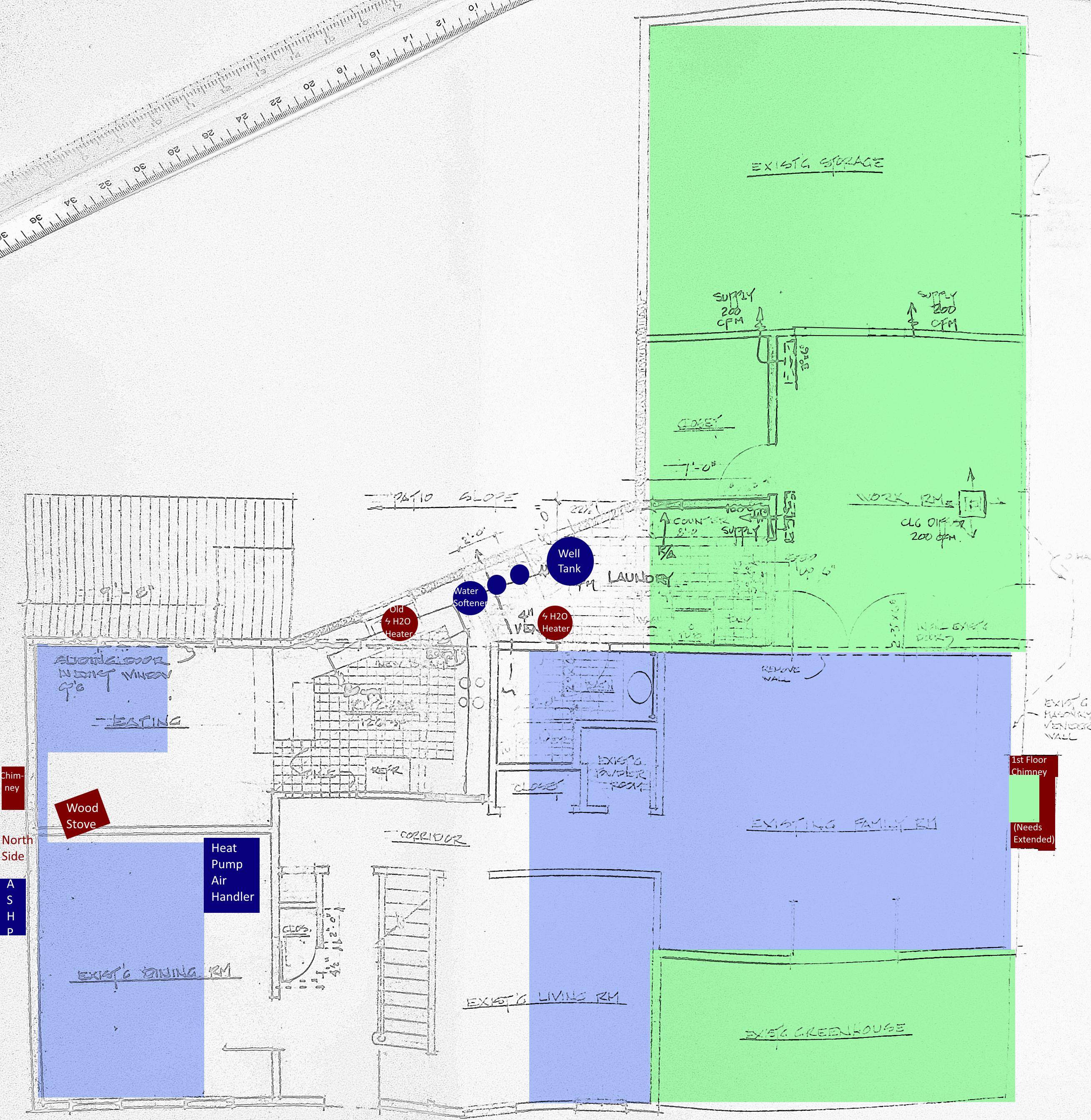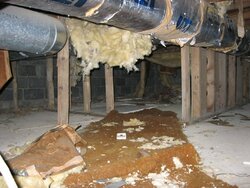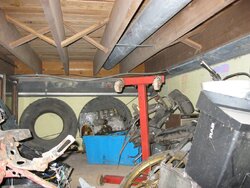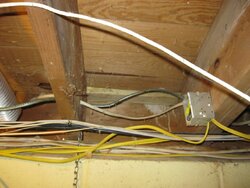After tackling deficient attic insulation (which made a BIG difference), getting a modern wood stove, and going all LED for lighting, we’ve lowered our yearly electric usage from ~30,000kWh to 20,000kWh in an all-electric home. Now we’ve got the time and enough funds to address the basement, which is the biggest remaining energy sink of the house. It’s uninsulated and has too many leaks.
We had a free energy audit done, and the company suggested spray foam for the entire band joist and basement ceiling. I was skeptical of that plan both because of the high price quoted, and because our basement houses not only our wood stove, but our heat pump, ductwork, water equipment, and my brother’s workshop area as well.
Here’s a map of our first floor, with the basement layout overlaid (blue is concrete-floored crawlspace, and green is uninsulated slab-on-grade, or tile for the greenhouse):

I’ve bought a foam gun and some 2” R-10 XPS foam board to start on the rim joist first of all, and we’re planning on replacing the electric water heater with an air-source heat pump model (good in all seasons, given the wood stove, and some welcome moisture control in humid summers).
Next, my brother wishes to focus on the larger crawlspace, as heat from the stove and inadequately-insulated ducts has a hard time reaching that end of the house, making things chillier in those rooms and the master bedroom above. After witnessing the original fiberglass batts fall from the joists years ago, he’s partial to replacing them with rock wool, then walling off the section beneath the family room so that fewer BTUs sink into the ground and more of the stove’s heat travels up the stairwell (we keep the door open in winter to aid heat diffusion).
I pointed out that insulating the crawlspace walls and floor instead wouldn’t take much more in materials, but could preserve airflow for a heat path and dehumidifying, while also serving as a barrier for air/moisture/radon if impermeable foam was used in place of rock wool. At that point he revealed he had a secret plan to keep the crawlspace as an extra storage area, and possibly dig out the core of the space for a fuller basement, which he feels floor insulation would interfere with. I’m not keen on either idea.
I know a very similar situation was discussed before, but wanted to hear your thoughts. I’m not sure how the walls facing the greenhouse and concrete slab impact the need for insulation, or if insulating the crawlspace floor is as great a concern, considering the largest heat differential will be near the stove and the exterior walls.



We had a free energy audit done, and the company suggested spray foam for the entire band joist and basement ceiling. I was skeptical of that plan both because of the high price quoted, and because our basement houses not only our wood stove, but our heat pump, ductwork, water equipment, and my brother’s workshop area as well.
Here’s a map of our first floor, with the basement layout overlaid (blue is concrete-floored crawlspace, and green is uninsulated slab-on-grade, or tile for the greenhouse):

I’ve bought a foam gun and some 2” R-10 XPS foam board to start on the rim joist first of all, and we’re planning on replacing the electric water heater with an air-source heat pump model (good in all seasons, given the wood stove, and some welcome moisture control in humid summers).
Next, my brother wishes to focus on the larger crawlspace, as heat from the stove and inadequately-insulated ducts has a hard time reaching that end of the house, making things chillier in those rooms and the master bedroom above. After witnessing the original fiberglass batts fall from the joists years ago, he’s partial to replacing them with rock wool, then walling off the section beneath the family room so that fewer BTUs sink into the ground and more of the stove’s heat travels up the stairwell (we keep the door open in winter to aid heat diffusion).
I pointed out that insulating the crawlspace walls and floor instead wouldn’t take much more in materials, but could preserve airflow for a heat path and dehumidifying, while also serving as a barrier for air/moisture/radon if impermeable foam was used in place of rock wool. At that point he revealed he had a secret plan to keep the crawlspace as an extra storage area, and possibly dig out the core of the space for a fuller basement, which he feels floor insulation would interfere with. I’m not keen on either idea.
I know a very similar situation was discussed before, but wanted to hear your thoughts. I’m not sure how the walls facing the greenhouse and concrete slab impact the need for insulation, or if insulating the crawlspace floor is as great a concern, considering the largest heat differential will be near the stove and the exterior walls.






